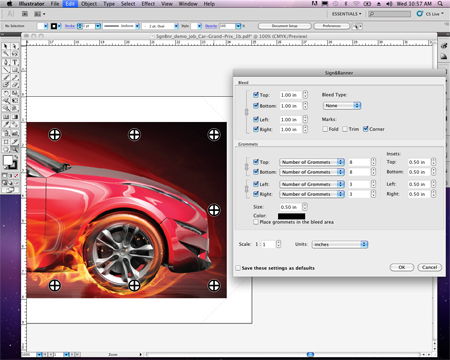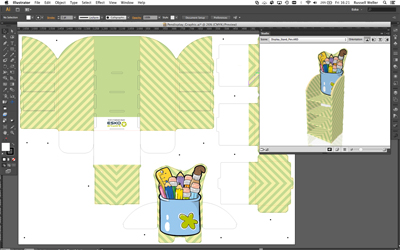Designs on new applications? Then you’ll need to catch up with developments in software packages that can help your creatives expand your business. Nessan Cleary investigates.
We've long argued in these pages that smart investments in software can squeeze additional productivity out of your existing hardware. But what about one area that's often overlooked - design software. This year’s Widthwise Survey data again threw up the fact that a significant proportion of large-format print solutions providers have diversified into design and are, or plan to, expand services in that area because there’s so much value-add to be gained by doing so.
In terms of design software the market leader is undoubtedly Adobe Illustrator CC, which requires a monthly subscription but is regularly updated. Amongst the latest features is a new Pencil tool that can draw more accurate curves, plus the ability to drag path segments into different shapes as well as enhancements to the perspective drawing tools.
It is still possible to buy the CS6 version with a perpetual license though you will have to dig around to find it.
Corel has just released a new version of its CorelDraw Graphics Suite X7 bundle. This has a very flexible interface, with a choice of six pre-set work spaces, to prioritise page layout and illustration or even to mimic the Adobe Illustrator screens. Corel has also improved the font handling, and given more control over fills and transparency, and there’s a new QR code generator.
As usual, Corel has included a huge range of different programs together, including the Photo Paint photo- editing program. It includes clipart and royalty free photos plus some 2,000 vehicle templates, one reason why CorelDraw remains highly popular with many sign makers. It can be bought outright, or via a monthly or annual subscription.
Both of these programs are extremely capable but there are other options designed specifically for working with wide-format printing. Dean Derhak, senior product manager for SAi’s FlexiSign, says that standard design programs such as Illustrator are more difficult to use in typical wide-format scenarios - such as for print-and-cut - because it won’t always close up the whole area around the cut path, which makes it more difficult to separate the graphic from the waste. Derhak adds: “Also Rip software needs to have these cut paths done in a certain way.”
There are several versions of FlexiSign, including: Designer, which doesn’t support output; Sign, for working with cut vinyl; and Sign Pro, which is suitable for both printed output and vinyl lettering. FlexiSign can also drive wide-format printers directly, useful for a single printer bureau.
Derhak points out that the learning curve can be a big barrier for many bureaux that might not necessarily have designers trained in complex applications like Illustrator.
A further problem is that many wide-format dealers see little value in selling software, so there’s often little advice on the different software options other than the Rip itself. To counter this SAi has persuaded HP to bundle FlexiSign together with its new Latex 300 printers, which should both add value to the printers and see more people using this software.
SAi has also addressed another big issue in the software world - namely the gradual move to selling software via a regular subscription. This was kick started by Adobe’s decision to only sell its design programs, including Illustrator, through a monthly subscription to its Creative Cloud service. Many other developers are also offering this now, though most give customers a choice.
Mark Blundell, SAi’s CEO, explains: “About half our users are interested in paying for this out of operating budget instead of their capital account.” It also means that people can temporarily license additional copies for a busy period without committing to a long-term cost. For the subscription version, SAi has combined FlexiSign Pro and PhotoPrint, which costs £49.95 per month, but anyone that signs up for a year can get it for £39.95, and this price carries on beyond the year.
Cadlink sells an alternative, SignLab 9.1, which includes a number of useful features, such as transparency support for vector, bitmap and gradient filled objects. There are pre-set patterns for contour cutting around objects. It installs buttons to Corel, Illustrator and Photoshop to send files from those applications to SignLab for further work.
EasySign has all the basic design tools that you would expect, including transparency, cloning and text on a path as well as the ability to measure colours. It’s possible to create templates and to create new shapes based on the boundary or outline of selected objects. It includes support for finishing, such as welding and cutting. You can buy it as a perpetual license, or just pay for a month at a time.
 Onyx has developed a couple of plug-ins to work with Illustrator, under the SmartApps brand, which are designed to simplify Illustrator’s use for wide-format production. The Sign&Banner plug-in includes a number of tools to simplify preparing banners for production by adding bleeds, which can be extended beyond the Illustrator limitations, as well as trim lines and grommet marks. It’s also possible to set up presets using Adobe Actions.
Onyx has developed a couple of plug-ins to work with Illustrator, under the SmartApps brand, which are designed to simplify Illustrator’s use for wide-format production. The Sign&Banner plug-in includes a number of tools to simplify preparing banners for production by adding bleeds, which can be extended beyond the Illustrator limitations, as well as trim lines and grommet marks. It’s also possible to set up presets using Adobe Actions.
There’s also a VehicleWraps plug-in that can take existing vehicle templates into Illustrator to create the panels, which can be individually labelled to make for easier installation. Bleeds and overlaps can be individually edited and you can generate a tile map to show where each panel should go.
For now these plug-ins only work up to the CS5.5 version of Illustrator but Onyx is planning to add support for Adobe’s Creative Cloud version, though there’s no release date set as yet.
Another program that is fast becoming popular amongst wide-format users is Esko’s ArtiosCad, developed to produce structural packaging, which also includes things like POS display boxes. It allows designers to work in 3D, rather than having to visualise a 3D product, whilst designing in 2D. It includes a library of common items that can often be used without much further work needed, but can also be treated as the starting point for other products. It has tools to help with folds to simplify construction of products, and it can also handle complex items such as curves. It can even produce a 3D movie of a inished design that can be shown to clients before producing a job. It can output in different formats, but is an obvious fit for Esko’s Kongsberg cutting tables.
Paul Bates, Esko’s UK marketing manager, says that one of its big advantages is multiple parts: “If you have a freestanding display made up of 14 parts it can output all of those parts in one file so it’s easier to handle when you output those parts for sheeting and cutting.”
There's a free plug-in to Illustrator to import ArtiosCad files whilst also retaining the layers and CAD data in Illustrator. There’s also a 3D studio plug-in to Illustrator that can include metallic effects on packaging designs. The Illustrator plug-ins support Adobe's Creative Cloud version.
Later this year Esko will update all of its software, including ArtiosCad, with the release of Suite 14, which will have the option to lease software through a cloud- based system, something that Bates says that many people are asking for. Another option is Kasemake, developed by AGCad, which also sells the Dyss range of cutting tables. Kasemake was developed for designing items such as packaging and display stands, with carton and corrugated boards. It includes a library of templates and can preview 3D designs and is meant to be a cheaper alternative than the Esko software.
Ultimately, there’s no one size fits all when it comes to design software - a sign design program might be a good fit for mainly flexible work, while a 3D packaging tool is better suited to working with rigid materials. For smaller bureaux, it’s tempting to mix design and output into a single application that can drive the printers but it’s probably best to separate the design from the Rip so that you can expand with more printers, and different types of printer, without compromising the Rip or having to change design programs later on. But in every case the most important aspect is whether or not the software can handle the processes that you need, such as closing cut paths or adding grommet marks, and with the minimum amount of fuss.
{jathumbnail off}


